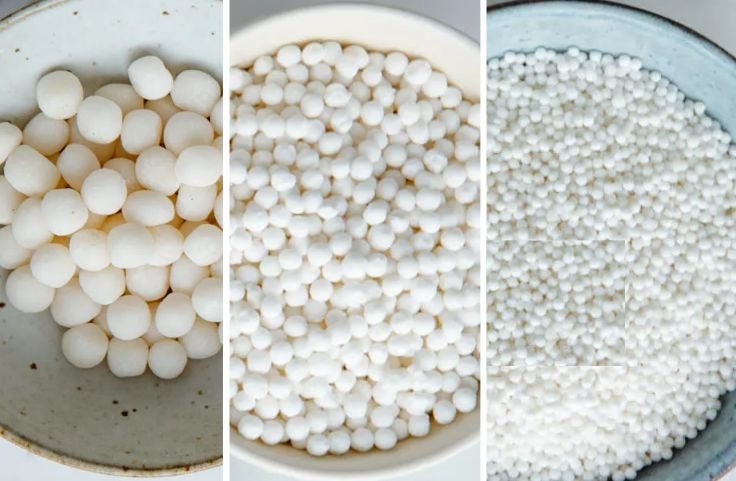Types of tapioca pearls go far beyond the classic boba. Each kind has its own texture, size, and use, perfect for everything from drinks to traditional desserts.
Tapioca pearls aren’t one-size-fits-all. Depending on their size, color, and preparation, they serve very different roles in the kitchen.
Some are crafted for slurping through bubble tea straws, others for slow-simmered desserts, and a few cook instantly for quick fixes.
Whether you’re chasing that perfect chew or crafting a silky pudding, choosing the right type of tapioca pearl makes all the difference.
This guide breaks down the different varieties, from small and large to instant and colored pearls, so you can match the right kind to your recipes.
If you’ve ever been confused at the store or ended up with mushy pearls, this is your shortcut to clarity, consistency, and tapioca success in every dish.
Related: Yes! Tapioca Pearls Are Gluten-Free, Here’s How
Table of Contents
- The Importance of Choosing the Right Tapioca Pearl
- Small Tapioca Pearls
- Large Tapioca Pearls
- Instant Tapioca Pearls
- Colored or Flavored Tapioca Pearls
- Mini Boba / Micro Tapioca Pearls
- Raw vs. Cooked vs. Semi-Cooked Pearls
- Tapioca Pearl Shapes and Specialty Variants
- Conclusion: Selecting the Right Tapioca Pearl for Your Recipe
- Frequently Asked Questions
The Importance of Choosing the Right Tapioca Pearl
Your recipe deserves the right pearl. Get the texture, flavor, and cooking method that works for your dish by understanding the types of tapioca pearls available.
Choosing the right tapioca pearl shapes how your dish turns out. Small pearls melt into creamy puddings, while large ones bring the chewiness bubble tea lovers crave.
Instant pearls are perfect when you’re short on time; they cook fast and still hold up in drinks or desserts.
Colored pearls add fun and flair to party treats, especially for kids. If you want a balance of soft and chewy, mini pearls offer just that.
Each type has its texture, cooking method, and ideal use. By picking the right one, you get the flavor and feel that fits your recipe.
Whether you’re making comfort food or trendy drinks, the tapioca pearls you choose can make the difference between a good result and a great one.
Recommended: The Best Tapioca Pearls for Pudding
Small Tapioca Pearls
Small tapioca pearls, usually 1 to 2 millimeters in size, are ideal for creamy desserts like tapioca pudding.
Their small size allows them to cook evenly and soften into a delicate, pleasant texture that blends smoothly into dishes.
To get the best results, you usually soak them for several hours or overnight before simmering in milk or flavored liquids until translucent and tender.
Beyond pudding, these pearls are also used as natural thickeners in pie fillings and custards.
They help bind ingredients without altering flavor, making them a go-to option for chefs and home cooks alike.
Their mild taste and soft chew make them easy to incorporate into recipes.
Whether you’re making a nostalgic dessert or need a gentle thickener, small tapioca pearls offer dependable texture and a comforting finish in sweet dishes around the world.
Here is a dedicated post on small tapioca pearls.
Related Posts
Tapioca Pearls Recipes: Soft, Chewy Delights
What Does Tapioca Pudding Contain?
How to Make Boba Pearls Without Tapioca Starch
Tapioca vs Boba: What’s the Difference?
What Are Tapioca Balls? Are They the Same as Tapioca Pearls?
Tapioca vs Crystal Boba: Differences, Uses, and Nutritional Values
Large Tapioca Pearls
Large tapioca pearls give your drink that satisfying chew you crave in bubble tea.
Ranging from 6 to 10 millimeters, they stand out in both size and texture.
When cooked right, they add a soft bounce that pairs perfectly with milk teas, iced drinks, and dessert cups.
To get that chewy center, you’ll need to boil them longer than small pearls.
Soaking before cooking helps them cook evenly and keeps them from turning mushy.
After boiling, let them rest in warm water so they stay soft and full.
You can also soak them in brown sugar syrup or flavored liquid to give them a sweet finish.
Whether you’re making bubble tea at home or adding them to a chilled dessert, these pearls add more than texture; they create an experience that keeps people sipping and scooping to the last bite.
For more on large tapioca pearls, check this post.
Instant Tapioca Pearls
If you want fast results without skipping quality, instant tapioca pearls are a smart choice.
They’re pre-cooked and dehydrated, so all you need is boiling water. No soaking, no long waits.
In just a few minutes, they’re ready for your pudding, smoothie, or dessert cup.
The texture is softer and less chewy than traditional pearls, which works well in recipes where you want a smooth, gentle bite.
Their mild flavor blends easily with sweet ingredients like coconut milk, vanilla, or fruit purées.
You can stir them into warm puddings or chill them for layered treats.
They’re great when you’re short on time but still want something satisfying.
If you’re new to tapioca or just need a quick fix, instant pearls help you pull off sweet recipes with ease and a clean, consistent finish every time. See an in-depth guide on instant tapioca pearls.
Colored or Flavored Tapioca Pearls
Colored or flavored tapioca pearls bring fun and flavor to your drinks and desserts.
Instead of the plain look and taste of regular pearls, these come in bright colors and sweet flavors like brown sugar, mango, strawberry, or passionfruit.
They’re made by adding food-safe dyes and flavorings to the tapioca base before cooking.
Some use natural fruit extracts for a cleaner taste. These pearls are perfect for bubble tea, especially when you want to match a color theme or add a fruity twist.
They cook the same way as regular large pearls but offer a playful, eye-catching result.
You can mix and match flavors or layer them in drinks for visual appeal.
If you’re hosting a party or just want something different, flavored and colored pearls make your tapioca experience more exciting and customizable.
Related: Brazilian Tapioca Crepes Recipe
Mini Boba / Micro Tapioca Pearls
Mini boba, or micro tapioca pearls, are perfect when you want something soft, quick to cook, and easy to enjoy.
These tiny pearls measure about 1 to 2 millimeters and cook in just a few minutes.
They’re tender enough to melt in your mouth, making them a great fit for puddings, fruit salads, and dessert soups.
Because of their size, they work well in recipes for kids or anyone who prefers a gentler texture.
You can stir them into light milk-based desserts or layer them into parfaits for a fun surprise in every spoonful.
They’re also a hit in Asian-style dessert soups and cold treats.
With their short cooking time and playful feel, mini boba adds both comfort and creativity to your kitchen.
Try them when you want something sweet, soft, and ready in minutes.
Related: Delicious Tapioca Pancakes Recipe
Raw vs. Cooked vs. Semi-Cooked Pearls
Not all tapioca pearls are ready the same way. To get the right texture in your dish or drink, you need to know which type you’re working with.
Raw Tapioca Pearls: Full Control, Longer Cooking Time
Raw tapioca pearls are completely uncooked. They’re hard, dry, and need about 30 minutes of boiling plus extra soaking.
If you like full control over the texture, this option gives you that freedom. But it requires patience and attention.
Undercooked pearls can taste gummy and feel unpleasant. Always check the packaging for the right cooking times.
When prepared properly, they give that classic chew in puddings and bubble tea.
Semi-Cooked Tapioca Pearls: Faster and Still Chewy
Semi-cooked pearls are a time-saver. They’re partially processed and only need about 10 to 15 minutes of boiling, followed by soaking.
You still get a nice chewy bite, just without the long wait.
These work well if you’re short on time but still want better texture than instant options.
Keep an eye on the package instructions; they help you get that soft center without overcooking the outside.
Cooked Tapioca Pearls: Instant and Convenient
Cooked tapioca pearls are the fastest option. They’re fully prepped and only need a quick boil or a few minutes of resting in hot water.
Some even come frozen and just need to be thawed. Great for beginners or anyone in a rush, these pearls are ready to serve almost immediately.
They don’t give you the same level of control, but they’re perfect for quick bubble tea or dessert bowls.
Always check the label to know if they’re ready to use.
Related: How to Make the Comforting Indian Sabudana
Tapioca Pearl Shapes and Specialty Variants
Tapioca pearls come in more than just one shape or size. From perfect spheres to chewy flakes and juice-filled balls, you’ve got plenty of fun textures to choose from.
Round Tapioca Pearls
These are the most common and are what you usually get in bubble tea.
They’re smooth, chewy, and easy to prepare. Round pearls give you a consistent bite and are great for sipping through wide straws.
You can find them in different sizes, from mini pearls to the large ones used in classic boba drinks.
Their smooth surface helps them hold flavor better, especially when soaked in syrups or teas.
Irregularly Shaped Pearls
Irregular pearls are less uniform and look more homemade. You might spot them in local markets or traditional kitchens.
They give you a mixed texture in every bite, with some parts softer and others chewier.
These usually take a little more attention during cooking, but the payoff is worth it.
They’re perfect if you enjoy rustic textures and like to try something different from the polished look of standard pearls.
Tapioca Strings or Flakes
These aren’t round at all. Tapioca strings or flakes look like flat shards or noodles.
They’re soft but still chewy, and they absorb flavors quickly. You’ll see them used in Asian dessert soups or chilled dishes.
They cook quickly and are easy to mix into drinks or puddings.
If you’re going for a delicate texture without the classic chew, this is a great option to try.
Bursting Boba
These are not your regular tapioca pearls. Bursting boba has a thin outer shell and a juicy center filled with fruity syrup.
When you bite into them, you get a splash of flavor that complements cold drinks like fruit teas or slushies.
They’re sweet on their own, so you don’t need to add much extra. Kids love them, and they’re a colorful way to mix up your bubble tea routine.
Related: How to Make Indian Sabudana Vada
Conclusion: Selecting the Right Tapioca Pearl for Your Recipe
Choosing the right tapioca pearl can make or break your recipe.
Size, texture, and cooking time all affect how the pearls blend with your dish.
Large pearls bring that chewy bite you expect in bubble tea, while smaller ones work better in puddings and dessert soups by thickening the mixture and offering a softer texture.
Instant pearls are great when you’re short on time, but traditional ones offer more control if you don’t mind the wait.
Paying attention to how long each type cooks helps you avoid mushy or undercooked pearls.
When you match the pearl to your dish’s needs, the result feels more thoughtful and balanced.
For step-by-step cooking instructions and tips, check out our other guides and give your tapioca recipes the texture and taste they deserve.
Frequently Asked Questions
What sizes of tapioca pearls are available, and how do they differ?
Small pearls (1–2 mm) soften and suit puddings; large pearls (≈6–10 mm) deliver chew in bubble tea.
What are instant tapioca pearls?
Pre‑cooked, dehydrated pearls need only boiling water. They cook quickly but yield a softer texture than traditional raw or semi‑cooked pearls.
What are colored or flavored tapioca pearls?
Regular tapioca pearls dyed or lightly flavored (e.g. mango, brown sugar, strawberry). They cook like standard pearls with added visual and taste interest.
What is popping boba and how is it different?
Juice‑filled spheres made via spherification, not from tapioca starch. They burst with flavor and lack chewy tapioca texture.

Chimeremeze Emeh is a writer and researcher passionate about Africa’s most transformative root crop—cassava. Through his work at cassavavaluechain.com, he explores the entire cassava industry, from cultivation and processing to its diverse applications in food, health, and industrial use.
He also writes for palmoilpalm.com, where he shares his extensive experience and deep-rooted knowledge of palm oil, covering red palm oil, palm kernel oil, and refined products. His work there reflects his lifelong connection to agriculture and his commitment to promoting sustainable value chains in Africa.
Driven by curiosity and purpose, Chimeremeze aims to shed light on how cassava continues to empower communities, strengthen food systems, and link traditional farming wisdom with modern innovation.

